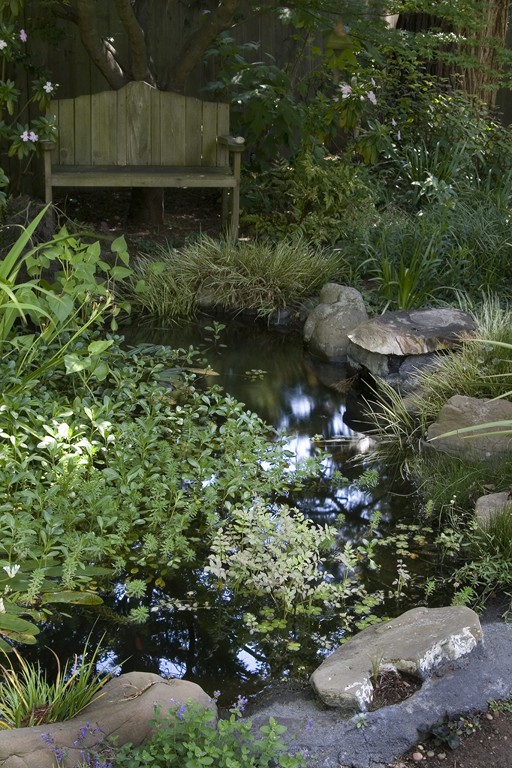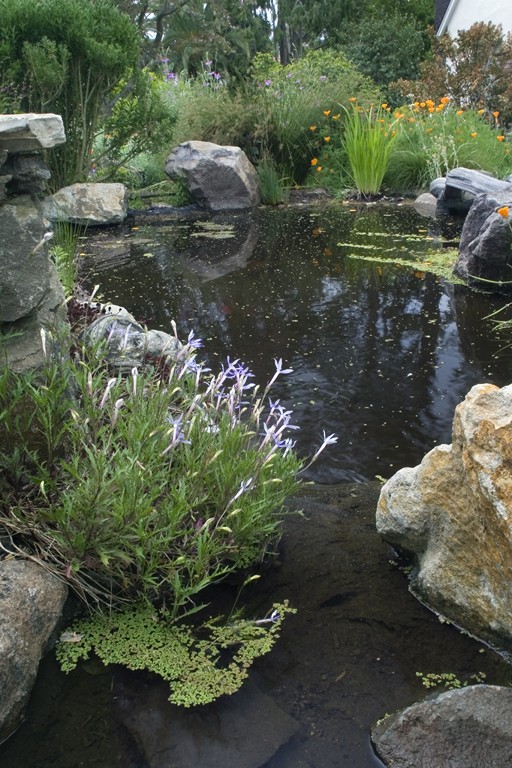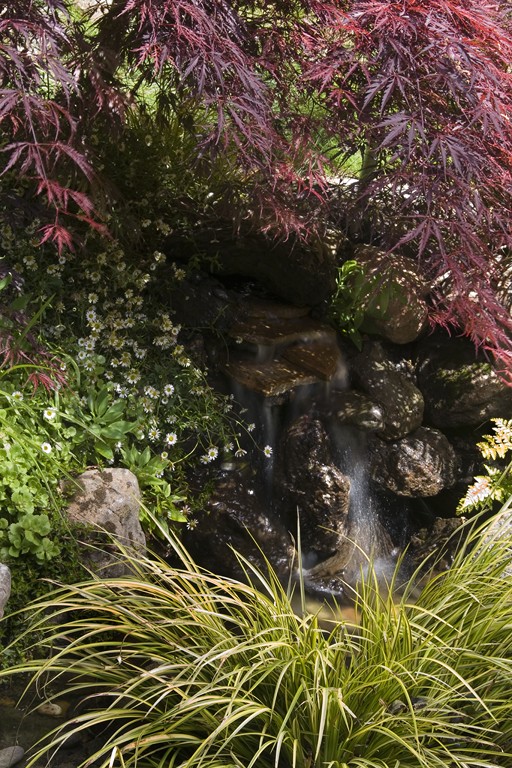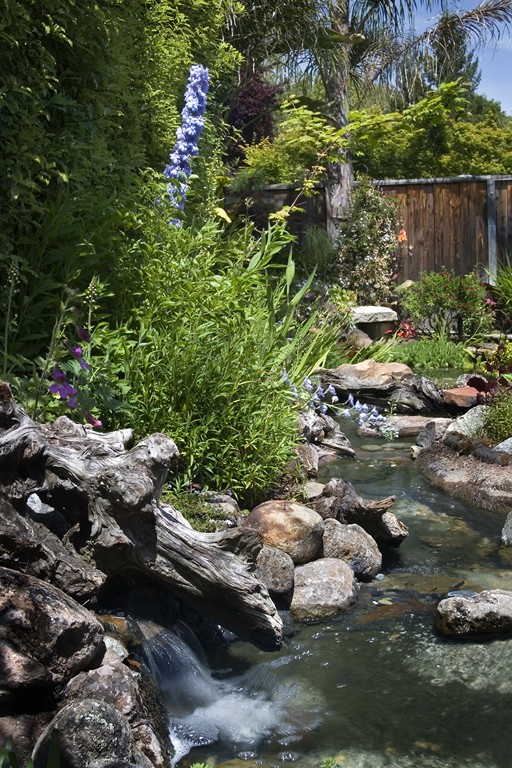Safe Havens

It’s one of the unavoidable results of living in urban or suburban areas: People who dwell in mostly built environments feel cut off from nature. This, of course, is one of the reasons why ponds and streams have become so popular among so many homeowners.
Adding spice to the sauce, I’ve found in recent years that this desire for naturalistic watershapes and elaborate gardens has also been attended by a desire on the parts of many of my clients to attract various forms of wildlife to participate in the setting. And it’s not just about fish in their ponds: With increasing frequency, my clients are also asking me to design and build spaces that will comfortably host a variety of creatures, including frogs, turtles, birds, insects and even small mammals.
For my part, I’ve come to see this as a reasonable extension of watershape and garden design and have become fascinated by what’s involved in developing spaces for wildlife. It’s a nuanced challenge – one that requires a specific understanding of the needs and behaviors of various species as well as unusually clear communication with that most complex of creatures: human beings.
STARTING WITH WATER
The foundation for all of this is the fact that more and more of my clients recognize and accept the notion that built ecosystems of any kind will function fully and well only if there is a balance of creatures – especially in places where the natural environment has been entirely subjugated by humankind. Indeed, they often tell me that they are aware of just how many species have inadvertently (or even deliberately) been wiped out as a result of urban development.
Whether you call this type of thinking idealism, environmentalism or just common sense, the fact is that many people see their gardens as places where they can do their part to recapture the balance, even if it’s just in a small way.
And it doesn’t hurt that most people are transfixed when they get the chance to see animals close up: There’s nothing to compete with the joy, for example, of seeing a hummingbird nest filled with chicks or hearing frogs croak on a warm summer evening. Moreover, quite often my clients will tell me that they grew up in areas where they had abundant wildlife around them and that they want to get back to those sorts of experiences.
| Despite recommendations to the contrary, I’m a firm believer that plants should be part of watershapes occupied by Koi and other fish: Their roots host beneficial bacteria that clear away fish wastes; they contribute oxygen to the system; and they provide shade and protective cover for fish and other creatures we want to attract to the water’s edge. (For all those reasons, I often use floating plant islands.) |
Whatever the motivation, I believe that watershape and landscape professionals have a wonderful opportunity to bring these pleasures to homeowners by considering fauna as a dynamic, practical design element. This can be tricky, however, and the balance you’re after can be hard to achieve: There isn’t a client anywhere, for example, who wants you to develop a backyard that becomes overrun with rats or other rodents that have arrived to compete with desirable creatures and end up destroying the setting.
To be successful, we must be aware that, as in nature, any space that meets the needs of one type of animal will very likely be ideal for the needs many others. So where we tend to think of birds and fish as being very different from one another (as well they are!), a pond that is good for fish will also likely be good for birds because of the insects that gather near the water and in the plant material we arrayed to generate bacteria that benefit the fish.
In other words, water is the unifying element and always occupies the heart of this discussion.
In fact and in a very real sense, you’ve already taken the most important of all steps toward creating habitats for a variety of animals simply by introducing water into your built spaces: Watershapes pull these scenes together – the water, its surface, its edges and the plant material and rocks that comprise its surroundings – just by being there.
LITTLE SWIMMERS
Of all the creatures most closely associates with watershapes, certainly fish occupy the top slots – with Koi being the kingpins when it comes to top-flight ponds.
Koi can indeed be dazzlingly beautiful and present the broadest imaginable spectrum of colors. They are also gregarious and seem to develop relationships with their keepers, who have often spent a great deal of money to obtain them and have also invested heavily in an environment dedicated to sustaining them properly.
With Koi (and other species) in our ponds, we must recognize that we have placed them in an artificial environment in which they are far more exposed and visible than they would be in a truly natural setting. We do so, of course, because not being able to see the fish would defeat the purpose of having them in the first place.
As with any artificial ecosystem, we’re presented with the challenge of crafting an environment in which fish waste is managed and algae blooms are discouraged. Plants are the key: The soil that contains them and their root structures host colonies of beneficial, waste-consuming bacteria, and the plants themselves produce some or all of the oxygen the fish need to survive.
| Turtles and frogs are among the most appealing of the creatures people want around their ponds and streams, but it can be tough to get them to feel at home. I do my best by including plants that draw the insects they like to eat as well as giving them some of the shelter they need to avoid predators. I also include secure hiding places under rocks or in grottos to give turtles in particular a place to go when the weather gets too chilly for them. |
As the ecosystem develops, the soil and plant structures eventually become places for insects to breed, in turn providing the fish with a food source. As the plants mature and their roots become established, they also offer hiding places for fish and give them places to lay their eggs. In addition, all that plant material absorbs nitrogen introduced by fish waste, thereby improving water quality and fostering growth.
This all seems so wonderfully natural and balanced that I have difficulty understanding serious collectors who believe that plants should be kept out of water occupied by Koi. If establishing a healthy ecosystem is about striking natural balances, I just can’t agree with that approach.
For one thing, plants are sources of oxygen. I typically place lilies, lotuses and emergent grasses on muddy edges or in planting pockets or on islands, using this greenery to beautify edge treatments and contrast with stone materials that intrude past and recede from the water’s boundary. I don’t rely on these plants to add all of the oxygen fish will require; rather, I see this as a supplement to waterfalls or aerators in maintaining an oxygen-rich environment.
For another, Koi really do need places to hide from predators. Depth is one way to protect them, and some installers set up stone grottos as safe havens – and that’s fine as long as the recesses are large enough to host several fish. I’ve used both of those approaches, but I still see plants as another layer of protection and am also a big proponent of floating islands (such as Islandscapes by Freedom Ponds, Albuquerque N.M. ), which serve the dual purpose of providing shelter for fish while offering areas where root systems deliver their full benefits to the ecosystem.
AMPHIBIANS AT WORK
Once you step past fish in thinking about wildlife, you get into much trickier areas because these other creatures are, obviously, far more mobile than our finny friends.
Take frogs as an example: I’ve found that it’s incredibly difficult to keep them in a given space with much consistency and that no two of them respond in quite the same way when introduced to a space. In my area, for example, I’ve found that if I’m working in a neighborhood that has tree frogs (quite small but very vocal and fun to watch), they’ll immediately take to a new watershape in good numbers – then will utterly vanish in a year or so, despite having seemed quite happy with the setting that whole time. Why this happens, I don’t know.
|
Dealing with Slitherers For whatever reason, snakes tend to scare people. This is why you should know (and, of course, let your clients know) that, by creating animal-friendly spaces, slinky reptiles may well come to the party. Personally, I don’t mind snakes: They help keep down populations of rodents, which represent the single greatest threat to the environments I’m trying to create, and, despite what some people think, snakes really don’t want to hang out with us, either. Even rattlesnakes are extremely shy and will avoid human contact if they can. Yes, there are some areas where rattlesnakes can be hazardous to children and pets, but in those cases, local snake-abatement services might come and remove them. For the most part, however, snakes rarely pose much of a problem. If it comes to pass that you do encounter a rattler on a patio, pathway or some other place where it’s not welcome, do what was recommended to me by a local humane society: Just break out a garden hose and drive it away with water. I’ve had to do this on several occasions and am happy to report that the snakes always quickly take their leave. R.D. |
But I keep trying to figure it out, because lots of my clients like frogs and find their croaking to be soothing or entertaining or the trigger of childhood memories. What I’ve learned is that frogs generally seek out moist areas around the water’s edge – where the insects they like to eat are in good supply and the perimeter plants give them many places to hide.
Their fondness for insects, of course, can create conflicts with clients who like frogs but don’t appreciate the prospect of having large quantities of insects hovering about. This is where communication comes in and I let my clients know that there’s a trade off if attracting frogs is important to them. If they’re willing, creating thickets of plants at water’s edge and setting up bog areas will be great for frogs, insects and fish alike.
Bullfrogs are a bit different than tree frogs in that they tend to be territorial and have a homing instinct – meaning they naturally prefer to hang out where they were raised. Even so, I’ve found that about nine in ten of them will move along and that just one will settle in and make the garden a permanent home. (I also warn owners that it’s likely these resident tree frogs will explore a bit and will likely find their ways indoors at some point. That possibility bothers some clients, but it actually seems to intrigue others.)
Turtles are another possibility and are quite similar to frogs with respect to their need for moist places and safety. But they also tend to be wanderers, with about one in every three or four staying on site. For those inclined to stay, keeping them happy is largely a matter of offering them a ready food source.
Also, Turtles need and seek shelter in cold weather, so it’s important to provide them with hiding places either outside the water or just beyond the water’s edge where they can stay safely, often for months at a time. Raccoons and rats can be a problem when turtles are in this torpid state, so I make sure to provide them with secure spaces under rocks or even in hollow boulders.
For the most part, I don’t introduce frogs into my clients’ environments, instead doing what I can to set things up so they’ll arrive on their own. I will introduce turtles, however, and often work with suppliers that specialize in turtles that have been abandoned by pet owners. (If you’re looking for turtles in your area, many children’s zoos provide rescue services or will know of agencies that do the same.)
ON WING
Animals that fly are much simpler to accommodate than waterborne or land-loving species, but they can also be quite difficult to “manage.” Insects, for example, are easy to attract and represent useful food sources for fish, frogs and birds alike. At the same time, they can become a huge nuisance if they overpopulate a given area.
Insects will gather wherever there’s a preferred food source – typically decomposing organic material. What this usually means for watershape environments is the need to plant fruit trees that produce in sufficient quantity that the clients are unable to keep up by harvesting and using the fruit themselves. The excess falls to the ground, rots and attract insects.
Common sense comes into play here, and every setting is a bit different. The type of fruit tree you deploy, for example, will depend on what grows readily in a given climate zone and also happens to be something the clients like to eat. The number of trees can vary, too, depending on the size of the garden (a small backyard, for example, might need only one or two trees) and their output.
However it goes, you want to avoid an overabundance of falling fruit and rotting material because there’s obviously such a thing as attracting too many insects. In addition, an overabundance increases the likelihood that the rotting fruit will also attract rats and raccoons.
| Attracting birds and flying insects to watergardens is pretty simple: What they want most in life are food and water. For insects, flowers and fallen fruit are wonderfully attractive (if you don’t go overboard). For birds, different types of feeders can be used to draw specific types (hummingbirds, for example, or songbirds). As for the water, birds prefer ‘intimate’ spaces where there are trees and shrubs around that offer them places to hide rather than large, open bodies of water. |
Here again, communication with the clients and establishing reasonable expectations is the key: You simply can’t sustain insects, turtles, frogs and fish without attracting rodents. There’s no way to be that selective when it comes to ecosystems, and the best you can do is to strive for balance.
The same principles apply with birds: You can’t attract the ones you want to see without also attracting some of their less presentable cousins. In this case, however, it’s possible to manipulate the situation just a bit by using bird feeders.
Hummingbird feeders, for example, are quite popular, easy to maintain and work quite well in most areas, and there are other bird feeders that do a wonderful job of attracting blue jays, crows, robins and sparrows as well as small birds such as finches and various songbirds.
But where the food supply is important for birds, a good water supply is crucial: Birds don’t generally gravitate toward open, still bodies of water in the middles of backyards, but a great many species seem to love shallow, moving streams and small fountains – especially when there are sheltering shrubs, trees or other plants nearby that will help them escape predators. Just as a matter of routine, birds like to move between the water and a perch in short intervals – and they also tend to take turns, which can be great fun to watch.
Through the years, I’ve had great success in designing spaces to attract birds. One was a pocket park in Walnut Creek, Calif., where previously crows had been just about the only visitors. With the trees, pond and various bird feeders we added, park visitors have seen great increases in the numbers and types of birds, including a variety of songbirds and other desirable species.
REVISE AND REVISIT
Obviously, regions and even neighborhoods differ in the types of species they harbor. In addition, each of those species has its idiosyncrasies, meaning there are few hard, fast rules to go by in setting up environments to attract and sustain them. The one common point, however, is that successful settings feature water – both quiescent and moving – along with combinations of aquatic plants, safe havens, fruit trees and other food sources that appeal to certain desirable species.
|
Protective Measures As mentioned in the accompanying text, when you create habitats for animals, it’s likely that some predators will show up as well, looking for the same water and food sources you’ve set up to appeal to more desirable species. This fact intimidates some clients, but I’m quick to let them know that, generally speaking, predators will not usually pose threats to people or the landscape. They can pose problems for dogs and cats, but for the most part, that’s a matter of keeping your pets safe at night. The most prolific predators I’ve encountered are raccoons, which have adapted themselves brilliantly to life in urban areas. They’re crafty and resourceful and can be a delight to observe, especially when they approach water and meticulously wash their hands (for hunting rather than for any sense of hygiene). Most of the time, raccoons will dig for grubs and other terrestrial insects and have an ability to make a mess of things. But the damage is more annoying than it is severe: I’ve found, for example, that they love hyacinths, will remove them from the water, take one bite out of the bulb and then discard the leftovers. My ready response: In areas with lots of raccoons, I don’t use hyacinths for my ponds – despite the fact they are among the most effective of all filtering plants and will remove more types of waste and clear more water than anything else I know. People also have lots of complaints about deer. Although they’re not predators, they can make short work of a garden and have a particular fondness for roses and will consume every blossom in sight in rapid order. Skunks can also be prolific but rarely pose much of a problem – with the obvious exception, of course. One substantial caution: If the environment is to include chickens or doves or other caged birds, skunks have been known to become the animal equivalent of mass murderers. They don’t always eat the birds, but they’ll sometimes slaughter them wholesale. R.D. |
In my experience, the outcomes turn on the available space, the client’s desires and the encompassing environment. This means that striking the right balance generally takes site-specific experimentation and a willingness to revise plans (especially for plants) as things move along. Because of that, I’m careful to let my clients know that achieving their goal of creating places rich with animal life will take time, often a period of years.
As I move forward with projects of this sort, I find myself reaching out constantly to get the information I need. I’ve read books and studied biology on my own, but I’ve also spent a good bit of time consulting with specialists – suppliers of Koi and other wonderful fish, curators at zoos and anyone else I can link up with on the Internet who may have worthy advice to offer. I also encourage my clients to do the same, my aim being to make them active participants in shaping and editing the space.
These projects, in other words, have set me on a path that never ends. I’ll never regret that the outcome of all my effort and exploration is a better understanding of nature and the way things interact within landscapes: It’s a process that, with time, has enabled me to add “animal life” to the list of design elements I use – a list that already includes rocks, plants, watershapes and more.
Best of all, working with animal life yields delights that touch something deep inside the human character. Even if it happens only in small, momentary ways, the presence of animals inevitably creates closer connections to nature not just for our clients, but for us as well.
Rick Driemeyer is founder and president of Both Sides of the Door, a watershape and landscape design/build firm based in Oakland, Calif. His design career began in Ann Arbor, Mich., in the early 1970s, when he became a specialist in interior landscapes and watershapes. After moving to California and expanding his work to include exteriors, he established his current company in 1981, deriving its unusual name from the fact that he now works with both interior and exterior spaces. An Arizona native, Driemeyer traveled extensively as a child with his family and has lived in Florida and Pennsylvania as well as Michigan. He credits this exposure to different types of landscapes and his parents’ love of the arts and nature as primary design influences.

























